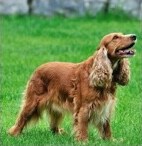 Primary and Secondary Seborrhea are dog skin problems where the epidermis (outer layer of the skin), the sebaceous (oil) glands and the hair follicles are over productive resulting in dry, flaky and sometimes greasy skin.
Primary and Secondary Seborrhea are dog skin problems where the epidermis (outer layer of the skin), the sebaceous (oil) glands and the hair follicles are over productive resulting in dry, flaky and sometimes greasy skin.
Greasy Seborrhea causes scales of oily dog skin to stick to the hair. Dry Seborrhea causes flakes of skin that are easily removed. The most commonly affected areas are around the ears, the legs, elbows, hocks and the chest area.
Apart from the very obvious flakes of skin, symptoms of Seborrhea include an unpleasant odor, excessive licking or scratching, a build up of oily crusts on the skin and thickening of the skin.
Cocker spaniels are more prone to the greasy form, of Seborrhea known as Seborrhea Oleosa, although they may have a combination of the dry type as well, Seborrhea Sicca.
Secondary Seborrhea is where the infection is a result of another untreated disease or infection, rather than a problem with the skin itself. Whereas Primary Seborrhea is seen in puppies as young as 10 weeks secondary Seborrhea can develop at any age.
When dealing with Primary Seborrhea it is essential to see a vet or pet dermatologist as the disease can cause secondary skin infections in dogs, such as yeast infections, ear infections and skin sores, which can then cause hair loss in dogs. It is important to get treatment for any other dog skin problems that arise from Seborrhea and vets will normally prescribe antibiotics to be started at the same time as the Seborrhea treatment.
Greasy Seborrhea can cause a waxy build up in the ear canal resulting in a secondary ear infection. As Cocker spaniels are prone to ear problems and deafness, it is essential to see a vet if Seborrhea is suspected as the earlier the diagnosis, the earlier the treatment can begin and the easier it will be to avoid complications.
Although, Primary Seborrhea is incurable, it is manageable and treatable with the correct medication. Medication may include shampoos and moisturizers that will have to be applied several times a week. Secondary Seborrhea can be managed by identifying the underlying cause. Parasite medication, such as flea and tick and worm tablets, should be given regularly to avoid further complications for the dog’s skin.
Steps to take to avoid the manifestation of dog skin problems involve finding the right diet for the dog. Cocker spaniels are notoriously picky with their food and are very vulnerable to food allergies, which can cause dry skin on dogs, as well as other symptoms such as excessive licking and scratching, vomiting and diarrhea.
Dog supplements that promote a healthy and shiny coat can be given daily. Herbs that boost the immune system and that have blood-cleansing properties can all help avoid the manifestation of primary and secondary skin infections in dogs.
Using the correct shampoo when washing and bathing a Cocker Spaniel will help to protect the dog’s coat. Human shampoo should never be used, as the PH balance is incorrect for dogs’ skin. Homeopathic or medical shampoos can be used, dependent on the severity of the dog’s skin condition. If home remedies do not work it is essential to see a vet to avoid unnecessary suffering.
Dog skin problems in Cocker Spaniels can severely reduce their quality of life if left untreated causing them mild discomfort to severe pain.
A vet may want to do other tests to establish whether a separate issue is causing the skin condition. Problems with the dog’s thyroid can cause symptoms exactly like Seborrhea and if the vet does not offer a test it is worth asking for one to rule out any underlying causes.
For more information about Cocker Spaniels, check out the highly recommended Complete A – Z Guide To The Cocker Spaniel package today.


